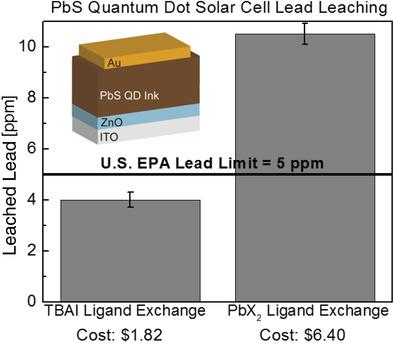当前位置:
X-MOL 学术
›
Adv. Sust. Syst.
›
论文详情
Our official English website, www.x-mol.net, welcomes your feedback! (Note: you will need to create a separate account there.)
Decreased Synthesis Costs and Waste Product Toxicity for Lead Sulfide Quantum Dot Ink Photovoltaics
Advanced Sustainable Systems ( IF 7.1 ) Pub Date : 2019-08-20 , DOI: 10.1002/adsu.201900061 Nicole Moody 1 , Dasol Yoon 2 , Anna Johnson 1 , Ella Wassweiler 3 , Michel Nasilowski 1 , Vladimir Bulović 3 , Moungi G. Bawendi 1
Advanced Sustainable Systems ( IF 7.1 ) Pub Date : 2019-08-20 , DOI: 10.1002/adsu.201900061 Nicole Moody 1 , Dasol Yoon 2 , Anna Johnson 1 , Ella Wassweiler 3 , Michel Nasilowski 1 , Vladimir Bulović 3 , Moungi G. Bawendi 1
Affiliation

|
Use of lead sulfide (PbS) colloidal quantum dot (QD) films as photoactive layers in photovoltaic (PV) devices typically requires replacement of native QD ligands with lead‐based capping ligands (i.e., PbX2, X = Br, I) for the best‐performing QD PVs. This ligand replacement process often requires additional solvents and toxic reagents. In the present study, an alternative PbS QD PV fabrication method with a lead‐free tetrabutylammonium iodide (TBAI) ligand source and lower material requirements and toxicity is demonstrated, yielding 10% power conversion efficient PVs with more than 1000 h of storage stability under ambient conditions. Evaluation of the economic and toxicological benefits of this new ligand exchange protocol reveals a 72% reduction in synthesis costs, an 80% reduction in solvent volumes, and a nearly 250‐fold reduction in lead waste generated compared to the previous PbX2‐based protocol for highest‐performing QD PVs. Most significantly, it is shown that unencapsulated PbS QD PVs made from this TBAI method leach less lead than U.S. Environmental Protection Agency limits and thus do not require hazardous waste disposal at the end of life. This finding implies a further decrease in expected device costs, extending progress toward large‐scale production of commercial PbS QD PVs with low environmental risk.
中文翻译:

降低硫化铅量子点油墨光伏的合成成本和废物毒性
使用硫化铅(PbS)胶体量子点(QD)膜作为光伏(PV)设备中的光敏层通常需要用基于铅的封盖配体(即PbX 2)代替天然QD配体,X = Br,I)表现最佳的QD PV。这种配体替换过程通常需要其他溶剂和有毒试剂。在本研究中,展示了一种可替代的PbS QD PV制造方法,该方法具有无铅四丁基碘化铵(TBAI)配体源,并具有较低的材料要求和毒性,可产生10%的功率转换效率PV,在室温下的储存稳定性超过1000 h情况。与以前的PbX 2相比,对这种新的配体交换方案的经济和毒理学优势的评估表明,合成成本降低了72%,溶剂体积降低了80%,产生的铅废物减少了近250倍针对性能最高的QD PV的基于协议。最重要的是,表明用这种TBAI方法制得的未封装PbS QD PV铅的浸出量少于美国环境保护局的限值,因此不需要在生命周期结束时进行有害废物处理。这一发现意味着预期的器件成本将进一步降低,从而向大规模生产具有低环境风险的商用PbS QD PV迈进了一步。
更新日期:2019-10-14
中文翻译:

降低硫化铅量子点油墨光伏的合成成本和废物毒性
使用硫化铅(PbS)胶体量子点(QD)膜作为光伏(PV)设备中的光敏层通常需要用基于铅的封盖配体(即PbX 2)代替天然QD配体,X = Br,I)表现最佳的QD PV。这种配体替换过程通常需要其他溶剂和有毒试剂。在本研究中,展示了一种可替代的PbS QD PV制造方法,该方法具有无铅四丁基碘化铵(TBAI)配体源,并具有较低的材料要求和毒性,可产生10%的功率转换效率PV,在室温下的储存稳定性超过1000 h情况。与以前的PbX 2相比,对这种新的配体交换方案的经济和毒理学优势的评估表明,合成成本降低了72%,溶剂体积降低了80%,产生的铅废物减少了近250倍针对性能最高的QD PV的基于协议。最重要的是,表明用这种TBAI方法制得的未封装PbS QD PV铅的浸出量少于美国环境保护局的限值,因此不需要在生命周期结束时进行有害废物处理。这一发现意味着预期的器件成本将进一步降低,从而向大规模生产具有低环境风险的商用PbS QD PV迈进了一步。



























 京公网安备 11010802027423号
京公网安备 11010802027423号